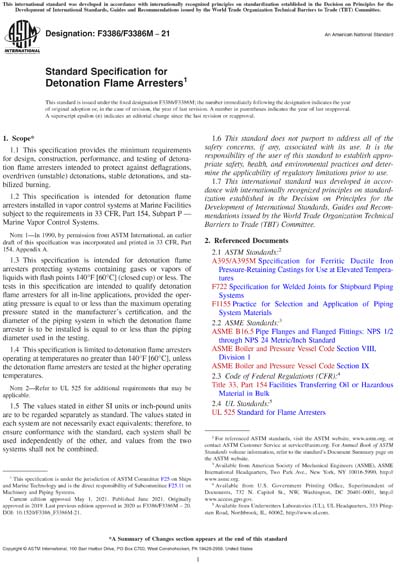Most recent
ASTM F3386/F3386M-21
Standard Specification for Detonation Flame Arresters
1.1This specification provides the minimum requirements for design, construction, performance, and testing of detonation flame arresters intended to protect against deflagrations, overdriven (unstable) detonations, stable detonations, and stabilized burning.
1.2This specification is intended for detonation flame arresters installed in vapor control systems at Marine Facilities subject to the requirements in 33 CFR, Part 154, Subpart P - Marine Vapor Control Systems.
Note 1:In 1990, by permission from ASTM International, an earlier draft of this specification was incorporated and printed in 33 CFR, Part 154, Appendix A.
1.3This specification is intended for detonation flame arresters protecting systems containing gases or vapors of liquids with flash points 140°F [60°C] (closed cup) or less. The tests in this specification are intended to qualify detonation flame arresters for all in-line applications, provided the operating pressure is equal to or less than the maximum operating pressure stated in the manufacturer's certification, and the diameter of the piping system in which the detonation flame arrester is to be installed is equal to or less than the piping diameter used in the testing.
1.4This specification is limited to detonation flame arresters operating at temperatures no greater than 140°F [60°C], unless the detonation flame arresters are tested at the higher operating temperatures.
Note 2:Refer to UL 525 for additional requirements that may be applicable.
1.5The values stated in either SI units or inch-pound units are to be regarded separately as standard. The values stated in each system are not necessarily exact equivalents; therefore, to ensure conformance with the standard, each system shall be used independently of the other, and values from the two systems shall not be combined.
1.6This standard does not purport to address all of the safety concerns, if any, associated with its use. It is the responsibility of the user of this standard to establish appropriate safety, health, and environmental practices and determine the applicability of regulatory limitations prior to use.
1.7This international standard was developed in accordance with internationally recognized principles on standardization established in the Decision on Principles for the Development of International Standards, Guides and Recommendations issued by the World Trade Organization Technical Barriers to Trade (TBT) Committee.
Content Provider
ASTM International [astm]






